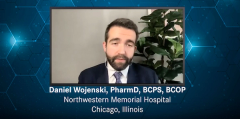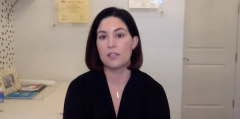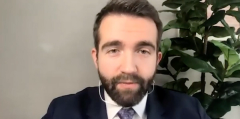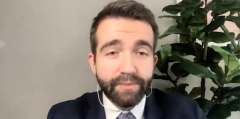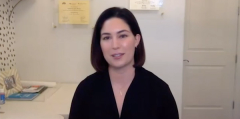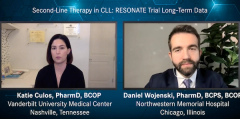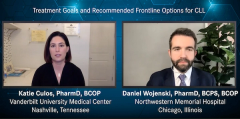
Treatment Goals and Recommended Frontline Options for CLL
Episodes in this series

Katie Culos, PharmD, BCOP and Daniel Wojenski, PharmD, BCPS, BCOP discuss the NCCN (National Comprehensive Cancer Center)-recommended front-line treatment options for patients with newly diagnosed CLL ([chronic lymphocytic leukemia)].
Katie Culos, PharmD, BCOP: Hello, and welcome to this Directions in Oncology Pharmacy™ Insights discussion, “Advancements and Updates in the Treatment Options for CLL.” I’m Dr. Katie Culos, a cellular therapy clinical pharmacist from Vanderbilt University Medical Center in Nashville, Tennessee. Joining me today in this virtual discussion is my colleague, Dr. Daniel Wojenski, a clinical hematology/oncology pharmacist from Northwestern Memorial Hospital in Chicago, Illinois.
Today we are going to discuss several treatment options and focus really on the advancements and updates in the use of BCL-2 inhibitors for management of patients with CLL. Let’s get started on our first topic today. Daniel, how about you walk us through the current NCCN recommended frontline treatment options for patients with newly diagnosed CLL.
Daniel Wojenski, PharmD, BCPS, BCOP: Looking at the NCCN recommended frontline treatment options, the treatment paradigm has shifted rapidly in these last five years and especially in these last two years with the data that came out from ECOG 1910, as well as the Alliance 041202 trial, that really propelled chemotherapy-free therapies to the frontline setting as the mainstay. What we’ve seen in our CLL population, especially in the last couple of years, was therapies such as ibrutinib, venetoclax, and acalabrutinib being the preferred first-line options for our patients.
Now, we still have chemotherapy options such as FCR that are available, and I think that the reason that that is still there in a first-line setting is that with the CLL10 study, we saw that patients receiving FCR had a median progression-free survival of 55.2 months. Patients with a mutated IGHV that didn’t have a deletion 17p or 11q were put into a deep remission and some have been in remission for over 10 years, so it’s still very hard for us to remove that option as a preferred option for certain patients, although we understand that is a pretty intense regimen that’s generally given to a younger population with fewer comorbidities that can tolerate such a regimen.
But what I would say, the mainstay for predominant patients, and this is for both younger and older populations, is chemotherapy-free approaches with BTK inhibitors or BCL-2 inhibitors that we’re seeing with NCCN. There are alternative options that still remain with chemotherapy, chemoimmunotherapy, although I would say in practice those are pretty limited for the amount that we’re actually seeing given to patients.
I think what’s also very important to note with these treatment options is that early intervention has not proven to improve outcomes with patients that have a diagnosis of CLL. The International Working Group of CLL published guidelines in 2018 that described criteria to initiate therapy which would be patients that have active disease that’s defined as progressive or symptomatic splenomegaly or lymphadenopathy, progressive bone marrow failure, progressive lymphocytosis, autoimmune complications, symptomatic or functional extranodal involvement, or B symptoms.
Now, with the goals of therapy, it’s important to note that we want to make sure that they’re tolerable and efficacious for our patients. So, when we’re selecting these based on the regimens that we have, fitness is always used to guide treatment in CLL. Now, the assessment of fitness varies between studies. Goals of therapy depend on a number of factors, including life expectancy, organ dysfunction, comorbidity, and performance status. Therefore, if you have a patient with a higher life expectancy, good performance status, and no organ dysfunction, your goal will likely be to put them into a deep and durable remission, also known as an MRD-negative remission. On the opposite end of the spectrum, if you have a patient that has a lower life expectancy, poor performance status, you’d likely expect that palliation is the goal of treatment for those patients.
When we’re looking at this, in terms of what I would say we see more commonly in my institution, our first-line therapy for most patients is likely going to be a BTK inhibitor based on the volume of data that we have, as well as the follow-up that we have with those studies. Mutated IGHV patients may benefit with FCR, as I mentioned, as long as patients are able to tolerate. But I will say that this is likely becoming kind of a unicorn in terms of the number of patients that we’d have that are able to tolerate this and select this option when we have chemotherapy-free approaches available.
We’ve had a number of patients that have opted for the venetoclax-based regimen in the first-line setting because of the fixed duration approach. So, when provided all that data, we have seen that some of our patients have elected to use that option. But I would say a majority of our patients currently are receiving BTK inhibitors in the frontline setting if they’re able to tolerate it, based on the current NCCN criteria and the data that we go through with our patients.
Newsletter
Stay informed on drug updates, treatment guidelines, and pharmacy practice trends—subscribe to Pharmacy Times for weekly clinical insights.

